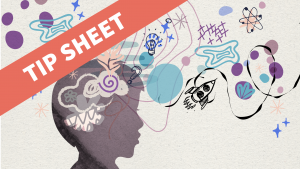
Despite ever-multiplying opportunities for constant stimulation online, youth self-reported experiences of “boredom” are high, with an estimated 91% of youth in North America reporting experiencing boredom “often.” Research indicates boredom avoidance is a primary reason young adults pick up their smartphones – and yet media use itself as a solution to this mental state of dissatisfaction seems to fall short. What is boredom? How can parents, caregivers and educators recognize boredom in youth and guide them towards developing the skills and solutions to cope with this common and frustrating state of discontent?
On This Page
Boredom Is A Unique Experience
Boredom is a psychological state, typically short-lived and situation dependent, that should not be confused with frustration, apathy, anger or sadness, though those experiences can be related to boredom, says Andreas Elpidorou, PhD, Professor of Philosophy, Director of the Liberal Studies Program at University of Louisville.
The unique experiential signature of boredom is an unpleasant state marked by both agitation and listlessness that also contains a strong desire to do something else, explains Elpidorou. “We are disengaged from and dissatisfied with what we do. Our situation doesn’t hold our attention. It doesn’t interest us. In a state of boredom, we’re moved to think of alternative situations and goals.”
This restlessness plus a desire for action that defines boredom helps distinguish it from laziness, says James Danckert, PhD, Professor of Cognitive Neuroscience and Research Area Head at University of Waterloo. A bored child is quite hostile to their boredom, he says, while laziness is closer to a state of apathy. “When we’re bored, we want something. We want something to engage in that’s meaningful or purposeful to us,” says Danckert. “The conundrum of boredom is that we don’t want anything that’s currently available to us.”
Motivation To Alleviate Boredom Can Have Mixed Consequences
This motivational push to find something to solve a current state of discontent can give rise to both beneficial and harmful consequences, says Elpidorou. “To deal with boredom, one not only needs to be able to motivate oneself to engage one’s situation, but one must also know what alternative situations will be interesting or meaningful,” he explains. Some youth may escape boredom by socializing, exercising, or engaging in creative production, whereas others may alleviate these feelings by engaging in risky behavior like reckless driving or binge drinking.
Boredom in and of itself is not good or bad, says Danckert, it’s what one does with the feeling that matters. “Boredom won’t make us be creative any more than it will make us be reckless. Those are choices that we make.”
Boredom Proneness By Developmental Stage
“Boredom proneness is the individual trait disposition to experience the state of boredom frequently and intensely,” says Danckert, whose research indicates that the boredom proneness of youth increases from age 8 onwards, peaking in the early to mid-teenage years.
This trend may relate to changes in brain development during this period, says Danckert, who notes that the more self-control one has, the less boredom is felt. As adolescents age into their late teens and early twenties, the brain’s prefrontal cortex is undergoing a significant stage of development, contributing to the maturation of complex skills like behavior and impulse control. “It’s no coincidence that boredom starts to drop off as teens gain more self-control,” he says. While later teens still report “in the moment” feelings of boredom, the ability to cope with it may be what is changing at this developmental stage.
Media Use An Inadequate Cure To Boredom
A 2020 study found a small but significant increase in reports of boredom between 2008 and 2017, a period of time where smartphones, social media, and the internet became much more prevalent in children’s lives, says Danckert. Despite the allure of media use for boredom alleviation, this correlation suggests that it may not be providing meaningful solutions.
“I see smartphones and social media as a passive solution to boredom,” explains Danckert. “When we go to our phones and doom scroll through Twitter, our minds are occupied, but it’s not particularly meaningful and it’s not particularly active. It’s not allowing us to demonstrate our own agency. For that reason, it’s not a particularly useful solution to boredom.”
Many people engage in a particular cycle of boredom and social media use that becomes repetitive and self-referential rather than curative, says Susan Matt, PhD, Presidential Distinguished Professor of History at Weber State University and co-author of Bored, Lonely, Angry, Stupid: Changing Feelings about Technology, from the Telegraph to Twitter. “People often describe posting ‘I’m bored’ while being on Instagram, and it becomes a circular system of turning to Instagram to relieve boredom, being bored while being on Instagram, then posting about being bored while being on Instagram,” she says.
Using Boredom Positively Is A Developed Skill
Boredom by itself does not solve problems rooted in lack of engagement or inadequate stimulation, says Elpidorou. “Using boredom for our benefit, or at least not to our detriment, is a skill that requires knowledge of oneself, the ability to know how to read a situation, and the facility to respond to the situation appropriately,” he says.
Parents and caregivers can help guide their children to develop this set of skills over time, especially in adolescence. Given the developments happening in the prefrontal cortex, “I always say to kids and families, we are actually serving as these teenagers’ frontal lobes. We are helping them to be able to make better decisions, to help them to stop and plan,” says Caley Arzamarski, PhD, NCSP, Psychologist and Clinical Assistant Professor of Child and Adolescent Psychiatry at Warren Alpert Medical School of Brown University.
Practice Increased Comfort With “Empty” Time
“In the age of digital devices, people have become extremely uncomfortable with empty time,” says Matt. The limitlessness of the Internet may have engendered changes in the general collective sense of self, with an expectation that the world should be providing endless stimulation, she notes. At the same time, this constant receiving of stimulation may be giving people fewer resources to deal with the world when the stimulation ceases.
When kids slow down and have a lot of unstructured time, they may experience difficult feelings surfacing, says Arzamarski, which can often be challenging to sit with. When in a state of constant stimulation and movement, “it’s almost like a snowglobe – you aren’t able to let those thoughts and feelings settle,” she says. Boredom presents an opportunity to sit with these emotions and practice getting better at processing more difficult feelings. “As you practice sitting in silence, with not a lot to do, that skill gets easier over time,” explains Arzamarski.
Reframe Boredom As A Solution
Previous generations talked about empty time differently, says Matt, framing it more as an opportunity for solitude. Solitude in this view is seen less as a lonely state but as a “revitalizing moment with yourself, to refresh yourself and renew yourself before rejoining society,” she says. “If we can remember that other generations dealt with similar situations, but didn’t always interpret them so negatively, that may help us.”
Encourage Youth Self-Agency In Finding Solutions
All parents are familiar with the phenomenon, particularly with young children, of a child saying, “I’m bored!” says Danckert. “What they’re really saying is ‘I’m bored, and I want you to fix it for me.’”
Parents often take this opportunity to provide a menu list of options (Play basketball! Read a book!) that are usually dismissed outright by the child, says Danckert. “What they’re saying with that dismissal is, they’ve seen those options, too. They know what’s available, but they don’t want those things at this time. And that is the conundrum of boredom.’ I want to be engaged with the world. I want to be doing something that matters to me, but I don’t want the currently available options.’”
Elpidorou suggests that the only real solutions to boredom must originate from the child. “It has to come from them,” he says. Danckert concurs – “You have to get buy-in from the child so that the child has to see their own agency in whatever that plan is. They have to have some sense of control or autonomy that they helped create whatever it is that you’re going to do to alleviate their feelings of boredom in order to find effective solutions.”
Avoid A Dismissive Attitude
It can be tempting to be reactive or dismissive when a child or adolescent complains of boredom, says Natalie Spencer Gwyn, PhD, from the School of Counseling, Walden University. Yet she stresses the importance of encouraging dialogue and conversation with a positive and proactive attitude. Otherwise, youth may develop even more negative feelings about experiencing boredom if they feel they are being dismissed or not listened to. Ask open questions to get at how they are really feeling, like “When you’re bored, how do you feel? Are you angry? Are you frustrated? Are you sad?”
Elpidorou also cautions against a dismissive attitude toward whatever media-based solutions children may be using to cope with boredom. “I think we don’t give youth enough credit that they’re engaging in activities that for them are meaningful. We can perhaps enhance the sense of meaning by having conversations about what they’re doing” instead of assuming that it isn’t providing anything of use, he suggests.
Discuss And Plan In Advance
The moment when a child is in a state of agitation, restlessness, or even aggression from boredom is not the best time to find solutions, says Danckert, who advocates for planning for boredom when in a calmer state. “Do it when they’re not bored. Sit down and talk to them and say, ‘Okay, next time you’re bored, what’s your list of four things that you might go to?’”
Provide Open-Ended And Self-Directed Alternatives
Optimally, alternatives to engaging in screen time for boredom alleviation should provide other types of mental and creative stimulation, says Spencer Gwyn. Free and low-cost options include simply going outside, walking the neighborhood, puzzles, and providing easy access to various materials for open-ended activities like blocks, Legos, magnet construction sets, and art materials, she suggests. “Encourage self-direction, but also choice.”
Matt encourages helping youth view screen time as just one of many tools in the toolbox of solutions to boredom and suggests facilitating conversation to get them to think of what other tools and activities would also be meaningful alternatives to media time.
Creating something like a “touch, feel and smell garden” outside encourages use of all the different senses and provides other opportunities for self-directed participation, says Spencer Gwen.
“It can encourage your youth to take on leadership activities, because they’re watering the garden and then they’re also participating in it. You can keep a journal about the growth of the plants and what you’re noticing and what you’re smelling and what you’re feeling to incorporate all of those senses.”
Foster Unique Solutions For Individual Children
Encourage children to find their own toolbox of solutions to boredom based on their personal interests, suggests Spencer Gwyn. Arzamarski concurs. “Every child is different, and their strengths and differences are what make them unique. And that’s our job as parents, to be able to help kids foster their uniqueness,” she says. As parents and caregivers who know your children best, you may be able to help them find activities related to their distinctive personalities and interests.
Account For Developmental Stages In Finding Solutions
Helping youth discover their own solutions for boredom takes different forms at different developmental stages, says Spencer Gwyn. “Think about the developmental level of the youth that you’re working with,” she says. For example, in a dialogue with a three-year-old, you want to make options specific and short, with just a few choices. With older children and teens, you can engage in more open-ended conversations, asking them “How would you do this? Give me a step-by-step plan of how we can go about making this better or different.”
Resist Social Pressure To Always Be Active Online
People are being trained to both advertise their own exciting lives, and to seek out excitement in return, even if their only way to access it is through a screen, says Matt. Social media can create social pressure for youth to always be engaging in “cool” things, and constantly “doing, doing, doing”, she notes.
Helping adolescents resist the social pressure and value on performative activity in favor of a “normal” life that balances quiet and down time with stimulation is worth it, suggests Arzamarski. Think about how media is being used and whether it’s providing this balance, she says. “Is the screen acting as a babysitter? How often are we using it, how much time is being used in this kind of more passive manner?”
Manage Natural Risk-Taking
Risk-taking behavior can often be one solution adolescents turn to as a response to boredom. Managing this may require “thinking outside the box,” says Spencer Gwyn. Instead of expecting that a teen not engage in any risky behavior, consider instead co-engaging in some healthy risk-taking behaviors with your child within a safe space, she suggests. “We can model some risk-taking behaviors that are not so risky but that encourage growth, self-development, and engagement in conversations.”
Make Time For Connection
Building a relationship that encourages conversation and connectedness with your child is central to encouraging healthy behavioral responses to boredom, says Arzamarski. “Relationships are the basis of almost every evidence-based practice when it comes to making a change in behavior,” she says. “That comes through talking and listening. Sometimes, the intervention in my office is just allowing parents time to sit with their child- to listen, to hear their questions, and to have a conversation.”
Find Social Time
Boredom and loneliness are often correlated, says Matt, who suggests that one easy way to improve boredom proneness is to increase opportunities for sociability whether that be onscreen or offscreen. “Plan for social occasions as a way to get back to face-to-face time.”
Behavioral Signs Of Boredom At School
Boredom at school may manifest in many different behaviors that are not typically understood as originating from boredom, says Spencer Gwyn.
These can include:
- Disruptive classroom behaviors like talking out of turn or outbursts in the classroom
- Outbursts during physical, group, or extracurricular activities
- Sensory cues like constant tapping of fingers, shaking of legs, or fidgeting
- School avoidance
- Leaving school during school hours
- Skipping school entirely
- Procrastination
Spencer Gwyn also cautions educators to look for bias against youth from diverse backgrounds, where boredom may more likely manifest as behavioral issues and concerns. She encourages teachers to look to make sure students from diverse cultural backgrounds have opportunities to serve in leadership roles and think about ways to engage students with different learning styles, particularly using movement, music, and arts.
Solutions to problematic school behavior resulting from boredom do not come overnight, she cautions. Be patient and resist the urge to punish or discipline or force redirection in the middle of an outburst. Instead, try to understand where the boredom is coming from, in which situations it starts for the child, to address the underlying cause. For sensory type issues, allow sensory activities or spinners if allowed in the school. If more support for serious behavior issues is needed, Spencer Gwyn suggests seeking help from professional mentors, leadership organizations, and special interest groups that foster creativity.
Considerations For Boredom With Neurodivergent Youth
People diagnosed with ADHD (Attention Deficit Hyperactivity Disorder) tend to have high levels of boredom and boredom proneness, says Danckert. For many with ADHD, boredom episodes may be quite anxiety-provoking in the anticipation of an uncomfortable experience.
Signs of boredom will differ among neurodivergent youth, especially in classrooms, says Spencer Gwyn, who notes the wide spectrum of neurodiversity and attendant behaviors. Neurodivergent youth may need but not be receiving additional academic support in classrooms, or conversely have intellectual giftedness that may manifest as tiredness and listlessness when bored.
Enlist professional help when needed to make sure neurodivergent youth are being supported in ways that make sense for the individual child, says Spencer Gwyn.
Curious about how the perceptions of boredom have changed over time? Watch Susan Matt, PhD (Presidential Distinguished Professor of History, Weber State University; Co-Author, “Bored, Lonely, Angry, Stupid: Changing Feelings about Technology, from the Telegraph to Twitter”) speak about the history of boredom at our #AskTheExperts webinar “On Boredom: Screen Time, Free Time, and Child Development” and read the transcript below.
Video Transcript
[Dr. Susan Matt] “We’ve looked at how [the idea of boredom] changed over the course of many decades and it’s an interesting story. One thing that makes it interesting, is that the condition did not really exist until the 19th century. There was no word “boredom” until the 1850s. The words ‘bored’ and ‘boring’ existed in the 18th century, those are words people used to describe the qualities of things, the qualities of experience. But the idea of having an inner state of boredom, an inner state of unease, distress, dissatisfaction that only entered English in the 1850s.
That’s not to say that people in the past didn’t feel vexed occasionally, when their work was monotonous or dull, or their days were dull. But they talk about the outside world being dull, not their inner state of being. Here’s just an example we pulled from a diary we found while doing our research – again and again in this diary, this doctor just keeps talking about how ‘dull’ it is. But what we found was that people were not particularly worried or troubled by the fact that their lives could be boring. That was part of what you expected with life. It was part of the human condition, perhaps. Perhaps people also had a wider array of resources to fight back against the dullness.
In the diaries we examined, we found lots of people talking about the ways they would combat what came to be known as ‘boredom,’ whether it was by ‘building air castles in their minds,’ or reading or walking or dreaming, but people were not as alarmed. Perhaps it’s little wonder, then, that in 1890, one of the best sellers of the year was this book “Blessed be Drudgery,” which talked about the virtuous state of doing the same old, same old, that life in a rut wasn’t so bad. I think that gives you a sense of the different dispositions people had in earlier decades.
What we found in our research, was at the turn of the century, the last century, as work became more automated, automated as people began to work in assembly lines, they certainly complained about the tedium they faced and called it boredom. And they often sought relief in new technologies, like first the phonograph, the movie theater, the radio. Some people at the time worried that they were deadening their senses by going to these mass entertainments that didn’t necessarily have a redemptive value. Some people thought that these technologies and in particular the radio, was making people less capable of sitting in solitude. So this current concern about screens has antecedents nearly a century old.
People in the teens and twenties and thirties were already debating what phonographs, phones, movies and radios were doing to people’s heads and hearts. And meanwhile, technology companies with these new entertainments were also marketing them as solutions to boredom. We’ve found advertisements for phonographs that say, you know, ‘Your house in the isolated countryside no longer needs to be so quiet and dull. You can have the entertainment within it.’
Technology companies a century ago began to realize that there was a big business in marketing to end dullness and boredom. In the 1930s, 1940 and 1950s, psychoanalysts and psychologists began to pay more attention to the condition. One psychoanalyst, Otto Fenichel, declared in the 1930s that people had a right to be diverted. People had a right to be entertained. In 1957, in a landmark study, a psychologist coined the phrase “the pathology of boredom” and declared that humans needed to be stimulated and needed to have a diversity of inputs to keep their minds healthy. By the 1980s, a boredom-proneness scale had been developed, and psychologists of various stripes were offering ways to measure and combat the emotion. When new technologies like TVs came into every household, some saw this as a solution to boredom, but others declared that it was causing a new epidemic of boredom and by the 1960s, people were talking about how bored these kinds of screens, television screens were, were making the American population. Certainly that has continued in the age of the smartphone.”





